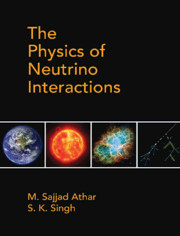Book contents
- Frontmatter
- Dedication
- Contents
- List of Figures
- List of Tables
- Preface
- Acknowledgments
- Chapter 1 Neutrino Properties and Its Interactions
- Chapter 2 Relativistic Particles and Neutrinos
- Chapter 3 Quantization of Free Particle Fields
- Chapter 4 Interacting Fields and Relativistic Perturbation Theory
- Chapter 5 Phenomenological Theory I: Nuclear β-decays and Weak Interaction of Leptons
- Chapter 6 Phenomenological Theory II: Weak Decays of Hadrons
- Chapter 7 Gauge Field Theories and Fundamental Interactions
- Chapter 8 Unified Theory of Electroweak Interactions
- Chapter 9 Neutrino and Electron Scattering from Point Particles
- Chapter 10 Neutrino scattering Cross Sections from Hadrons: Quasielastic Scattering
- Chapter 11 Neutrino Scattering from Hadrons: Inelastic Scattering (I)
- Chapter 12 Neutrino Scattering from Hadrons: Inelastic Scattering (II)
- Chapter 13 Neutrino Scattering from Hadrons: Deep Inelastic Scattering
- Chapter 14 Weak Quasielastic v(⊽)-nucleus Scattering
- Chapter 15 Inelastic Scattering of (Anti)neutrinos from Nuclei
- Chapter 16 Deep Inelastic Scattering of (Anti)neutrinos from Nuclei
- Chapter 17 Neutrino Sources and Detection of Neutrinos
- Chapter 18 Neutrino Mixing and Oscillations
- Chapter 19 Neutrino Astrophysics and the Synthesis of Elements
- Chapter 20 Neutrino Interactions Beyond the Standard Model
- Appendices
- Appendix A Lorentz Transformation and Covariance of the Dirac Equation
- Appendix B Cabibbo Theory
- Appendix C Some Properties of Pauli and Dirac Matrices and Spin Density Matrices
- Appendix D Leptonic and Hadronic Tensors
- Appendix E General Expression for the Total Scattering Cross Section and Decay Rates
- Appendix F Expressions of N(q2), the Coefficients of the Polarization Observables
- References
- Index
Chapter 20 - Neutrino Interactions Beyond the Standard Model
Published online by Cambridge University Press: 22 May 2020
- Frontmatter
- Dedication
- Contents
- List of Figures
- List of Tables
- Preface
- Acknowledgments
- Chapter 1 Neutrino Properties and Its Interactions
- Chapter 2 Relativistic Particles and Neutrinos
- Chapter 3 Quantization of Free Particle Fields
- Chapter 4 Interacting Fields and Relativistic Perturbation Theory
- Chapter 5 Phenomenological Theory I: Nuclear β-decays and Weak Interaction of Leptons
- Chapter 6 Phenomenological Theory II: Weak Decays of Hadrons
- Chapter 7 Gauge Field Theories and Fundamental Interactions
- Chapter 8 Unified Theory of Electroweak Interactions
- Chapter 9 Neutrino and Electron Scattering from Point Particles
- Chapter 10 Neutrino scattering Cross Sections from Hadrons: Quasielastic Scattering
- Chapter 11 Neutrino Scattering from Hadrons: Inelastic Scattering (I)
- Chapter 12 Neutrino Scattering from Hadrons: Inelastic Scattering (II)
- Chapter 13 Neutrino Scattering from Hadrons: Deep Inelastic Scattering
- Chapter 14 Weak Quasielastic v(⊽)-nucleus Scattering
- Chapter 15 Inelastic Scattering of (Anti)neutrinos from Nuclei
- Chapter 16 Deep Inelastic Scattering of (Anti)neutrinos from Nuclei
- Chapter 17 Neutrino Sources and Detection of Neutrinos
- Chapter 18 Neutrino Mixing and Oscillations
- Chapter 19 Neutrino Astrophysics and the Synthesis of Elements
- Chapter 20 Neutrino Interactions Beyond the Standard Model
- Appendices
- Appendix A Lorentz Transformation and Covariance of the Dirac Equation
- Appendix B Cabibbo Theory
- Appendix C Some Properties of Pauli and Dirac Matrices and Spin Density Matrices
- Appendix D Leptonic and Hadronic Tensors
- Appendix E General Expression for the Total Scattering Cross Section and Decay Rates
- Appendix F Expressions of N(q2), the Coefficients of the Polarization Observables
- References
- Index
Summary
Introduction
The phenomenon of neutrino oscillation discussed in Chapter 18 implies thatneutrinos have finite mass. The phenomenology of neutrino oscillationdetermines only the mass square differences but not the absolute masses ofthe neutrinos. The scalar and fermionic structure of the standard model doesnot allow neutrinos to have non-zero mass. There is also the possibilitythat neutrinos may have magnetic moments (intrinsic or transition)considerably larger than the prediction of the standard model. Moreover,there are anomalous results in the measurements of neutrino and antineutrinooscillation parameters in various regions of energies which suggest that thestandard model description in terms of three weak flavor doublets of leptonsand quarks is not adequate to describe weak interactions and there may existadditional flavor of neutrinos which are non-interacting i.e. sterile. Allthese processes suggest that although the standard model has been aspectacular success in describing most electroweak processes, there is needfor physics beyond the standard model.
Moreover, there are many other rare physical processes driven by weakinteractions which have been studied for a long time theoretically as wellas experimentally and are not explained by the standard model. Theexperimental observations of these processes would establish the physicsbeyond the standard model. The subject of physics beyond the standard modelis too vast to be described in space of a chapter but we discuss here, someof the neutrino processes to introduce the subject.
(i) Neutrinoless double beta decay (NDBD) and Majorana neutrinos
(ii) Lepton flavor violating (LFV) decays of elementary particles
(iii) Flavor changing neutral current (FCNC)
(iv) Existence of non-standard interaction in high precision weakprocesses.
Netrinoless Double-beta Decay
General considerations
The problem of double-beta decays (DBD) involving two-neutrino double-betadecay (2νββ) and neutrinolessdouble-beta decay (0νββ) has been withus for more than 80 years after it was first discussed by Goeppert-Mayer inthe case of (2νββ) in 1935 [1062] soonafter the Fermi theory of β-decay was formulated[23] and the process of 0νββ wasdiscussed by Furry in 1939[1063] after a new theory of neutrino was given byMajorana [121].
- Type
- Chapter
- Information
- The Physics of Neutrino Interactions , pp. 775 - 794Publisher: Cambridge University PressPrint publication year: 2020

